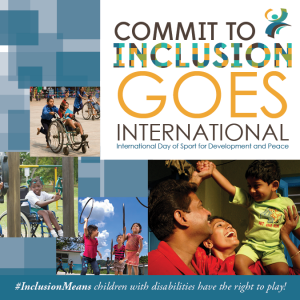Commit to Inclusion goes International!
On this day, April 6, 2015, we join the world in celebrating International Day of Sport for Development and Peace (IDSDP). Sport was recognized as a tool to contribute to the United Nations’ objectives for development and peace by the UN General Assembly. The adoption of this day signifies the increasing recognition by the United Nations of the positive influence that sport can have on the advancement of human rights, and social and economic development.
“Sport can help reduce the stigma and discrimination associated with disability because it can transform community attitudes about persons with disabilities by highlighting their skills and reducing the tendency to see the disability instead of the person. Through sport, persons without disabilities interact with persons with disabilities in a positive context forcing them to reshape assumptions about what persons with disabilities can and cannot do.’[1]
-United Nations Office of Sport for Development and Peace
Too often the rights of children and adolescents to physical education, physical activity, sport, recreation and play are not being realized. These areas are viewed as non-essentials and thus face consistent lack of support at all levels and the participants are repeatedly denied access. However, evidence shows they are critical to healthy child development, life-long good health and social cohesion. While numerous international documents outline the right to participation on an equal basis with their peers without disabilities, there continues to be exclusion and discrimination, both in the formation of new policies and practices at the international, national and local level.
The Convention on the Rights of Persons with Disabilities (CRPD) – adopted in 2006 and ratified by 151 States Parties to date – expands on the right for persons with disabilities to participate in sport, recreation and leisure, as well as the right of children with disabilities to play, in the fullest expression seen to date in a human rights convention.[1] The serious lack of participation in physical activity[2] is a major public health concern and even more so for the approximately 1 billion people living with disabilities, which the research says are at a much greater risk for developing serious health problems associated with a sedentary lifestyle. Typically, children and adolescents with disabilities are the last to be included in school-based physical education and community-based sports and recreation programmes. The problem is that patterns of inactivity in childhood and adolescence lead to higher rates of inactivity, obesity and other health problems in adulthood like non-communicable diseases or NCDs (4th leading risk factor for global mortality[3]).
Inequalities and discrimination span from community and school-based physical activity programmes, like physical education, to organized and informal sport and recreation programmes, to access play spaces like community playgrounds, as well as sporting and leisure venues. At some point every person with disabilities will face exclusion of some form in this areas. At the same, time even after the adoption of the CRPD, there continue to be major international organizations and Governments that do not incorporate the rights of persons with disabilities in their policies and strategies. As such there is a critical need to educate and raise awareness about the rights of children and adolescents with disabilities and provide a platform for sharing good practices and showing how it can be done with limited resources.
To address the issue stated above the GPcwd Task Force on Physical Activity and Sport with lead organizations the American College of Sports Medicine (ACSM), Institute for Human Centered Design (IHCD), and Lakeshore Foundation will join forces with the Commit to Inclusion campaign by creating an international expansion. This collaboration will build an international activation campaign using social media and the internet to end the exclusion of children and adolescents with disabilities from physical activity and all associated areas (physical education, sport, recreation, play).
What can you or your organization do to foster a more inclusive community, programme or policy?
Stay tuned to see how you can make your Commitment to Inclusion!
[1] United Nations Enable Website: http://www.un.org/disabilities/default.asp?id=1563
[2] Note: Physical activity is defined as any bodily movement produced by skeletal muscles that requires energy expenditure. (http://www.who.int/topics/physical_activity/en/) and therefore is being used as the overall term to cover the related areas covered by this Task Force and the campaign, namely physical education, sport, recreation and play.



